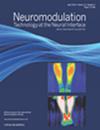多裂肌恢复性神经刺激治疗既往腰椎手术后慢性腰痛:单中心,连续病例系列。
IF 3.2
3区 医学
Q2 CLINICAL NEUROLOGY
引用次数: 0
摘要
目的:腰椎多裂肌恢复性神经刺激是治疗慢性非特异性腰痛(CLBP)的一种新方法。先前的研究排除了有腰椎手术史的患者。在这项研究中,我们描述了既往腰椎手术后CLBP患者的预后。材料和方法:这是一个单中心、连续的病例系列。主要结局指标是治疗后最初12个月腰痛(LBP)和Oswestry残疾指数(ODI)的基线数值评定评分(NRS)的变化。次要结局是NRS和ODI评分具有最小临床重要差异(MCID)的患者数量,患者对其管理满意度的短期评估,既往手术类型与结果之间的关系,以及不良事件的发生率。结果:该队列包括26例患者(男性12例;14个女性;平均年龄56岁),平均6.9年前做过腰椎手术;16人随访12个月,9人随访6个月。1例患者(3.6%)发生术后感染并需要取出器械。平均ODI和LBP NRS及其95% ci从基线41.8(36.5-46.5)连续下降到6个月时的29.3(22.1-36.6)和12个月时的28.1 (21.8-34.4),NRS分别从6.4(5.5-7.0),3.8(3.1-4.6)和3.6(2.5-4.7)。患者对治疗的满意度非常高。在10例(40%)ODI和NRS均有改善的患者中观察到MCIDs,其中10例患者在其中一个变量上有改善,而在另一个变量上没有改善。先前腰椎手术的类型不影响结果。无器械相关并发症。结论:腰椎手术后恢复性神经刺激的早期结果与未手术的患者相似。需要进一步的前瞻性临床研究来确定这些发现的有效性。本文章由计算机程序翻译,如有差异,请以英文原文为准。
Restorative Neurostimulation of the Multifidus for Chronic Low Back Pain After Prior Lumbar Spinal Surgery: A Single-Center, Consecutive Case Series
Objectives
Restorative neurostimulation of the lumbar multifidus muscle is a novel therapy for chronic nonspecific low back pain (CLBP). Previous studies have excluded patients with prior lumbar surgery. In this study, we describe outcomes in patients with CLBP after prior lumbar surgery.
Materials and Methods
This was a single-center, consecutive case series. The primary outcome measure was the change from baseline numeric rating score (NRS) for low back pain (LBP) and Oswestry Disability Index (ODI) in the first 12 months after treatment. Secondary outcomes were number of patients having minimal clinically important difference (MCID) in NRS and ODI scores, Short Assessment of Patient Satisfaction with their management, relationships between type of prior surgery and outcome, and incidence of adverse events.
Results
The cohort comprised 26 patients (12 men; 14 women; mean age 56 years) who had their lumbar surgery a mean 6.9 years previously; 16 were followed up for 12 months and nine for >six months. One patient (3.6%) had a postoperative infection and required device removal. Both mean ODI and LBP NRS and their 95% CIs decreased serially from baseline 41.8 (36.5–46.5) to 29.3 (22.1–36.6) at six months and 28.1 (21.8–34.4) at 12 months (ODI), and from 6.4 (5.5–7.0), 3.8 (3.1–4.6) and 3.6 (2.5–4.7), respectively, for NRS. Patient levels of satisfaction with treatment were very high. MCIDs were observed in ten patients (40%) who experienced improvement in both their ODI (by >10) and NRS (by >2), and in ten patients who experienced improvement in one of these variables but not the other. The type of prior lumbar surgery did not influence outcomes. There were no device-related complications.
Conclusions
The early outcome profiles after restorative neurostimulation after lumbar spinal surgery are similar to those reported in patients without prior surgery. Further prospective clinical studies are required to establish the validity of these findings.
求助全文
通过发布文献求助,成功后即可免费获取论文全文。
去求助
来源期刊

Neuromodulation
医学-临床神经学
CiteScore
6.40
自引率
3.60%
发文量
978
审稿时长
54 days
期刊介绍:
Neuromodulation: Technology at the Neural Interface is the preeminent journal in the area of neuromodulation, providing our readership with the state of the art clinical, translational, and basic science research in the field. For clinicians, engineers, scientists and members of the biotechnology industry alike, Neuromodulation provides timely and rigorously peer-reviewed articles on the technology, science, and clinical application of devices that interface with the nervous system to treat disease and improve function.
 求助内容:
求助内容: 应助结果提醒方式:
应助结果提醒方式:


